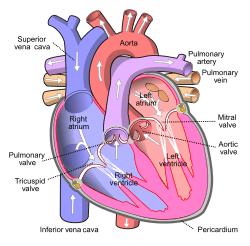Venae cavae facts for kids
Quick facts for kids Venae cavae |
|
|---|---|
 |
|
| The human heart and other structures, with superior and inferior vena cava labeled on left |
The venae cavae are two very large veins in your body. Think of them as big highways for blood! Their job is to carry blood that has been used by your body back to your heart. This blood is called deoxygenated blood because it has given away its oxygen to your body's cells.
In humans, there are two main venae cavae:
- The superior vena cava
- The inferior vena cava
Both of these large veins empty into a part of your heart called the right atrium. This is the first chamber of the heart that receives blood from the body. These veins are found a little to the right side of your body.
Contents
What Are Venae Cavae?
The venae cavae are like the main return pipes for your blood. They bring blood that is low in oxygen back to your heart. Your heart then sends this blood to your lungs to pick up fresh oxygen. After that, the oxygen-rich blood is pumped out to the rest of your body.
The Inferior Vena Cava
The inferior vena cava is the largest vein in the human body. It collects deoxygenated blood from the lower parts of your body. This includes your legs, feet, and your belly area. It travels upwards, next to a large artery called the aorta, to reach your heart.
The Superior Vena Cava
The superior vena cava collects deoxygenated blood from the upper parts of your body. This includes your head, neck, and arms. It is formed when two other veins, called the left and right brachiocephalic veins, join together. This large vein is located above your heart.
How Blood Returns to the Heart
Your heart has four main chambers. The right atrium is the top right chamber. It acts like a receiving room for all the deoxygenated blood coming back from your body.
The inferior vena cava brings blood from below your heart. The superior vena cava brings blood from above your heart. Both of these large veins deliver their blood directly into the right atrium. A smaller vein called the coronary sinus also brings blood from the heart muscle itself into the right atrium.
Once the right atrium is full, it pushes the blood into the next chamber, the right ventricle. From there, the blood is pumped to your lungs to get oxygen.
See also
 In Spanish: Venas cavas para niños
In Spanish: Venas cavas para niños

